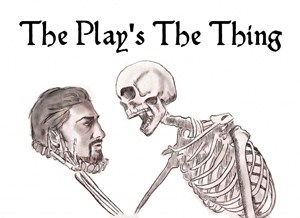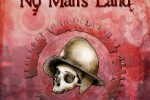The Play’s the Thing
The Play’s the Thing is a complete storytelling game system written by Mark Truman, Patrick Johnson, and Marissa Kelly and published by Magpie Games.
By Cape Rust

THE PLAY’S THE THING – A SHAKESPEAREAN RPG
About a week ago I came across an interesting game concept called The Play’s the Thing – A Shakespearean RPG by fledgling RPG company Magpie Games. My first encounter with this game occurred on Kickstarter… big surprise, a developer trying to raise money on Kickstarter right? Well, this game is 329% funded and it got funded quickly, like, two days quickly! Mark Truman, Patrick Johnson, Marissa Kelly, and Editor John Wick have put together a storytelling game that gives players a chance to rewrite Shakespeare’s plays. Who wouldn’t like to add some plot twists like Yorick rising from the grave to regain possession of his skull or Romeo and Juliet actually hooking up, having a child and their kid murdering the unhappy couple to take charge of both of the still feuding families?
The Play’s the Thing was born during Game Chef 2011 where game developers are challenged to develop a playable tabletop roleplaying game in one week based on 4 ingredients and 1 theme. If you hadn’t guessed it, this year’s theme was Shakespeare and The Play’s the Thing captured runner up honors. Lucky for us, Mr. Truman and his merry band decided to take the next step and raise funds to produce this game.
In this game, the players are part of a troupe trying to put on one of Shakespeare’s plays. Now for those of you who read Shakespeare in school, you know how confusing things can get. If you have seen modern adaptations, they are still confusing and if you are in fact an actor and have ever been involved with a Shakespearean production, then you have felt all of the joys and pain that Shakespeare and productions of his works have to offer. I don’t hide the fact that I have been involved in community theatre and that there are some actors who believe they could direct the show better than the actual director. The Play’s the Thing allows actors to do just that. The beauty of this concept is that there is no opening night, no long rehearsals, no makeup, no set building, no set strike, and when a game session is over ,no one’s artistic sensibilities should be bruised.
If you normally play RPGs, be warned: this is a storytelling RPG. What does that mean to the experienced tabletop player? It means there aren’t going to be large amounts of rules crunch. There are few dice rolls and the person who is the Playwright won’t need to hide behind a screen. You can’t really twink your character and this system isn’t about leveling up. If the aforementioned things are all that you love about RPGs, then this game might not be your favorite. I am not saying you shouldn’t try it, but if you do try it, it might challenge how you think about RPGs. This game is truly focused on the story, not the stats. Some folks like to call this one of those touchy feely games. One thing I love about this game is the small amount of stuff you need to get started.
I have not gotten to play a session yet but here is how I understand the game to work: You create an Actor (PC for you lovers of crunch). Each Actor has three stats: Logos, Pathos and Ethos. I’ll describe each in case you are a knuckle dragger like me. Logos is your verbal acumen and control over events in the play, Pathos his how you emote and your ability to control other Actors in the play, and Ethos represents your narrative understanding and your ability to control the setting of the play. Those three stats have ranks from one to three and the player has six points to spread out among those stats. After point allocation each Actor must select a type this is a little like a class or archetype in more traditional game systems. Those three stats have ranks from one to three and the player has six points to spread out among those stats. The actor types are The Lead, The Ham, The Villain, and The Ingenue. Each actor type has three personality aspects to it and these aspects are your onstage persona, offstage persona, and direction. These aspects provide advantages and disadvantages in game. Direction is interesting as it gives the Playwright some leverage over the actor. An example of direction for The Ham Actor reads- At the Playwrights request, The Ham must perform a soliloquy. I have always been a fan of disadvantages and all of the directions are interesting and appear to add flavor.
After the Actors have been created, the Playwright describes the plot of the play and casts the major characters. The rules encourage the Playwright to produce a known Shakespearian play or a new work. I see this as a slight weakness in the system. Many people have heard of Shakespeare and some of his works are well known, while others names may be known but the actual chunky bits of the play are not widely known. If I was acting as the playwright, I can only see producing Romeo and Juliet or Macbeth once or twice with the same group before you need to move on fresh material. To solve this I would recommend renting the movie version of famous plays or reading the Cliffs notes. This will give the playwright a better idea of how the play should go and will make the rewrites more interesting during game play. If the playwright decides to go with a non-Shakespearian play, the previous advice still stands, unless it is an “original” work. Based on my readings, I would stick with a well known Shakespearian play the first time you run the game. This will alleviate some of the problems a group will encounter when they find themselves in an unfamiliar setting and allow you all to concentrate on the rules and most importantly, having fun.
After the play is chosen and described to the players by the playwright, the show is cast. The casting involves Plots, Parts and Places as well as roles. After the actors bid on roles and determine which parts and plots they will bring they start act one. There is a process to the plots and parts which is not difficult to figure out. Once all of the pieces are in place, the characters start to act out the scene as written. The actors are limited to the scene described by the director, but actors being actors have their own interpretation of how the play should go and can spend a story point to yell cut and suggest an edit. If the Playwright accepts the edit, the Actor receives a story point. If not, the actor may roll dice with varying target numbers to force edits that run from trivial to major edits. There are mechanics that allow the Actor to add additional dice, but with a cost. The Actor must hit a target number equal to or greater than the target number to push their edit thru. After the edit has played itself out, the act ends. This goes on for five acts with the Playwright describing the setting and action of each following act.
There are more rules to the game, but I felt like an overview was important. The rules include a list of parts, plots, and sets, as well as character sheets, name placards, and a blank cast list. This game intrigues me. I can’t begin to figure out how to write a game in three thousand words or less in one week. Games like The Play’s the Thing are truly “role” playing games. Yes, there are dice involved but they are not the focus. I see this game being a big hit at Cons. Because character progression isn’t an issue, it would be great as a one night stand. The Play’s the Thing would fill in wonderfully as what I like to call a gateway game. Gateway games are those games you can play with people who might be adverse to RPGs but love story telling. I could easily see myself playing this game with my family during the holidays or with my fellow community theater actors. For more information on The Play’s the Thing, check out www.magpiegames.com. There you will find links to the creators’s pages as well as a link to their Kickstarter page. To Mark Truman, Patrick Johnson, Marissa Kelly and Editor John Wick I say this: Well played!


